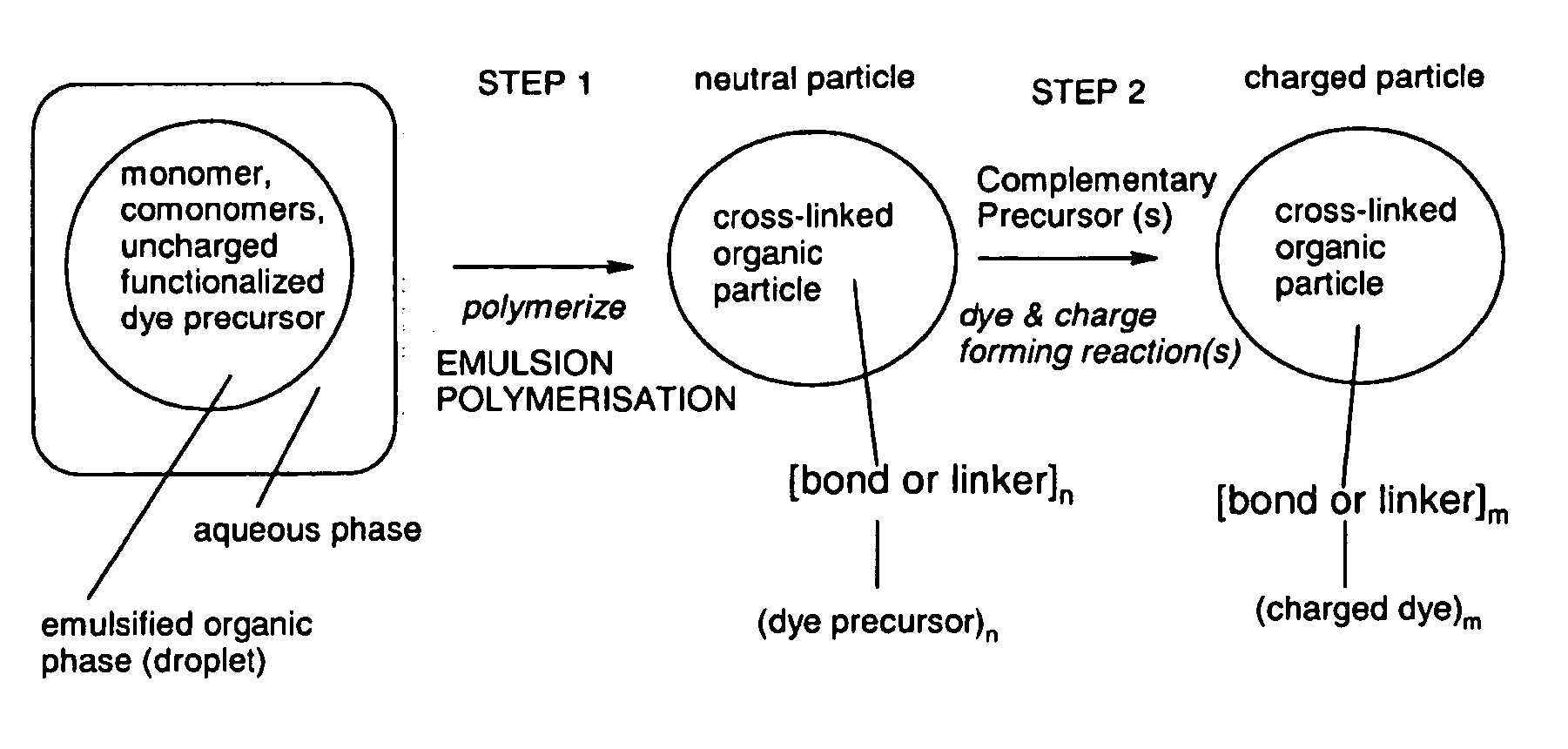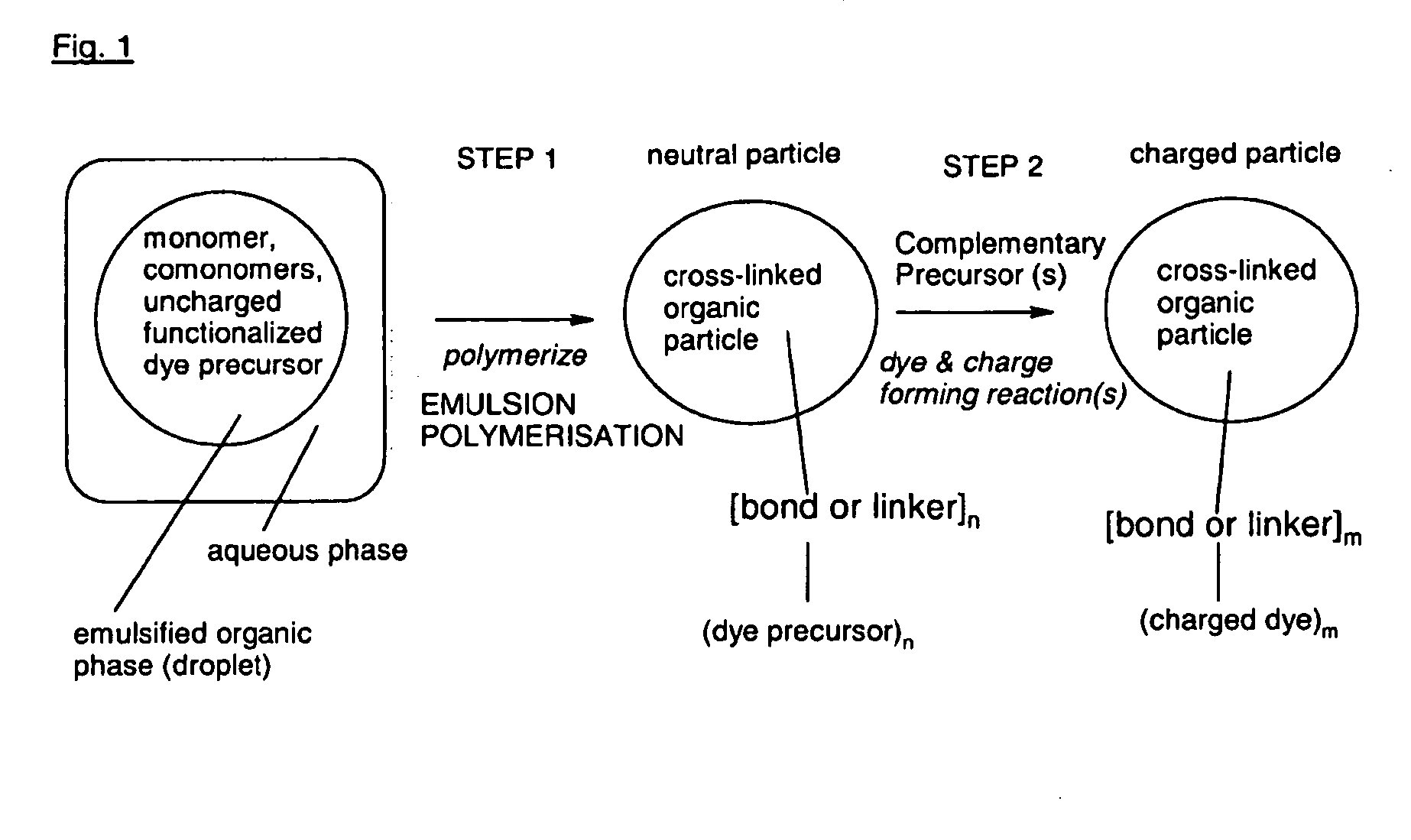Coloured organic electrophoretic particles
a technology of electrophoretic particles and organic dyes, applied in the direction of diaryl/triaryl methane dyes, organic compounds of group 4/14 elements, conductive materials, etc., can solve the problems of adverse low molecular fragments, heterodisperse particles, and further increase chromophore loadings, so as to increase chromophore loadings, high charge loadings, and color loadings. high
- Summary
- Abstract
- Description
- Claims
- Application Information
AI Technical Summary
Benefits of technology
Problems solved by technology
Method used
Image
Examples
example 1
Manufacture of Charged Blue Particles According to an Inventive Two-Step Procedure and the Resulting Particles
[0246]Step 1: Synthesis of Neutral Copolymer Particle of Styrene, Para-Divinylbenzene and Compound 103 (Polymer 104) with a Precursor Component for a Blue Chromophore
[0247](n is a natural number, and the bold line “” marks an ethylene or ethantriyl moiety via which the dye radicals represented in brackets are bound to the particle polystyrene scaffold)
[0248]The nano-particle of the composition of formula (104) is obtained by the following procedure: A mixture of 2.1 g freshly distilled styrene, 0.6 g freshly distilled para-divinyl benzene and 0.3 g of compound (103) (see below) are emulsified in degassed distilled water (36 ml) containing 10.0 mg sodium hydrogen carbonate and 140 mg sodium dodecyl sulphate (Fluka) under a nitrogen atmosphere for 15 minutes at 70° C. under stirring at 500 Upm. After that time, the polymerisation is initiated by the addition of 16 mg potassium...
example 1.2
Further Charged-Dye Carrying Particles
[0262]In analogy to the preceding example, the following particles 105-2A-105-2F are prepared from the corresponding ketones 2A-2F:
ExampleRz105-2Omethyl105-2An-octyl105-2Bn-dodecyl105-2Cn-octadecyl105-2D—CH2CH2—(OCH2CH2)3O(CH2)11CH3105-2E—CH2CH2—(OCH2CH2)2O(CH2)17CH3105-2F—CH2CH2OCH2CH2CH2—Si(CH3)2—(O—Si(CH3)2)ca. 11—OSi(CH3)2—CH2CH2CH2CH3
[0263]General preparation of the corresponding ketone precursors of the above listed derivatives exemplified for compound 2B:
[0264]a) Preparation of Common Precursor:
[0265]44.0 g of aluminum trichloride are dissolved at 0° C. in 200 ml dichloroethane. To this mixture are added 57.7 g of 4-chlorobenzoic acid chloride, dissolved in 50 ml dichloroethane over 30 minutes to form a red brown clear solution. This mixture is then treated with 44.0 g of N,N-dimethylamine, dissolved in 40 ml dichloromethane. The resulting mixture is stirred for 18 h whereby the reaction mixture warms up to room temperature. It is then po...
example 1.3
Further Charged-Dye Carrying Particles
[0275]In analogy to the preceding examples, the following particles are prepared with two elongated chains on either nitrogen of the ketone precursor:
ExampleRz2Gn-octadecyl2H—CH2CH2—(OCH2CH2)3O(CH2)11CH32IE—CH2CH2—(OCH2CH2)2O(CH2)17CH32J—CH2CH2OCH2CH2CH2—Si(CH3)2—(O—Si(CH3)2)ca. 11—OSi(CH3)2—CH2CH2CH2CH3
[0276]The corresponding ketones are obtained as is exemplified for compound 2G:
[0277]According the procedure given for the preparation of 2B, 7.8 g of N-methyl-octylamine, 3.0 g of para-dichloro benzophenone, 3.6 g sodium t. butoxide, 0.12 g palladium acetate and 0.32 g of 2-(di-t.butylphosphino)biphenyl (from Strem chemicals) are heated in 50 ml toluene to 100° C. to give after the usual work-up procedure 6.1 g of the keto amine 2G. 1H-NMR (CDCl3, 300 MHz): δ 0.90 (t, 6H); 1.25-1.37 (m, 60H); 1.58-1.65 (broad m, 4H); 3.02 (s, 6H); 3.38 (t, 4H); 6.67 (dd, 4H); 7.73 (dd, 4H).
[0278]Data for
[0279]2′G: 1H-NMR (CDCl3, 300 MHz): δ 0.89 (t, 6H); 1.24-1....
PUM
| Property | Measurement | Unit |
|---|---|---|
| Temperature | aaaaa | aaaaa |
| Temperature | aaaaa | aaaaa |
| Fraction | aaaaa | aaaaa |
Abstract
Description
Claims
Application Information
 Login to View More
Login to View More - R&D
- Intellectual Property
- Life Sciences
- Materials
- Tech Scout
- Unparalleled Data Quality
- Higher Quality Content
- 60% Fewer Hallucinations
Browse by: Latest US Patents, China's latest patents, Technical Efficacy Thesaurus, Application Domain, Technology Topic, Popular Technical Reports.
© 2025 PatSnap. All rights reserved.Legal|Privacy policy|Modern Slavery Act Transparency Statement|Sitemap|About US| Contact US: help@patsnap.com



